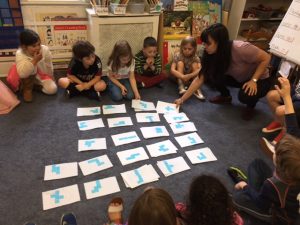Laying the Foundation for Addition by Exploring Parts of Six.
Kindergarten students decomposed the number six by placing square inch tiles into different arrangements and then recorded how they saw the arrangements using numbers. One of the goals of this problem was to help students understand that numbers can be decomposed (broken apart) in many ways. Developing an understanding of part-part-whole relationships is the first critical step to grasping the concepts of addition and subtraction, properties, and algorithms (NCTM, 2014, pg. 11). For example, in later years, decomposition (part-part-total understanding) of multi-digit numbers are used in place value concepts and the operations of addition/subtraction, multiplication/division by applying the various properties of commutative, associative, and distributive.
Differentiating Through an Open Problem:
How Many Ways Can Six Tiles Be Arranged?
Each child arranged tiles in as many ways as they could. This open problem was accessible to every student in the class, and at the same time provided differentiation because of the challenging open-ended nature of the problem (see below, the same problem given at the college level). The class came together and examined all of the possible ways of arranging six tiles “side-to-side, and corner-to-corner”. Through this exploration, the geometric concepts of congruence and transformations (flips, slides, turns), were introduced. The students found 20 ways to arrange six tiles.
Six Tiles Problem by Professor David Meredith:
Below is the same six tiles problem given to mathematics students at San Francisco State University by Professor Meredith, of the mathematics department. Prior to San Francisco State Univ., David was a professor at MIT, and a Woodrow Wilson Fellow. Meredith’s students found 35 distinct non-congruent ways to arrange six tiles.
2014 National Council of Teachers of Mathematics, Putting Essential Understanding of Addition and Subtraction into Practice.








